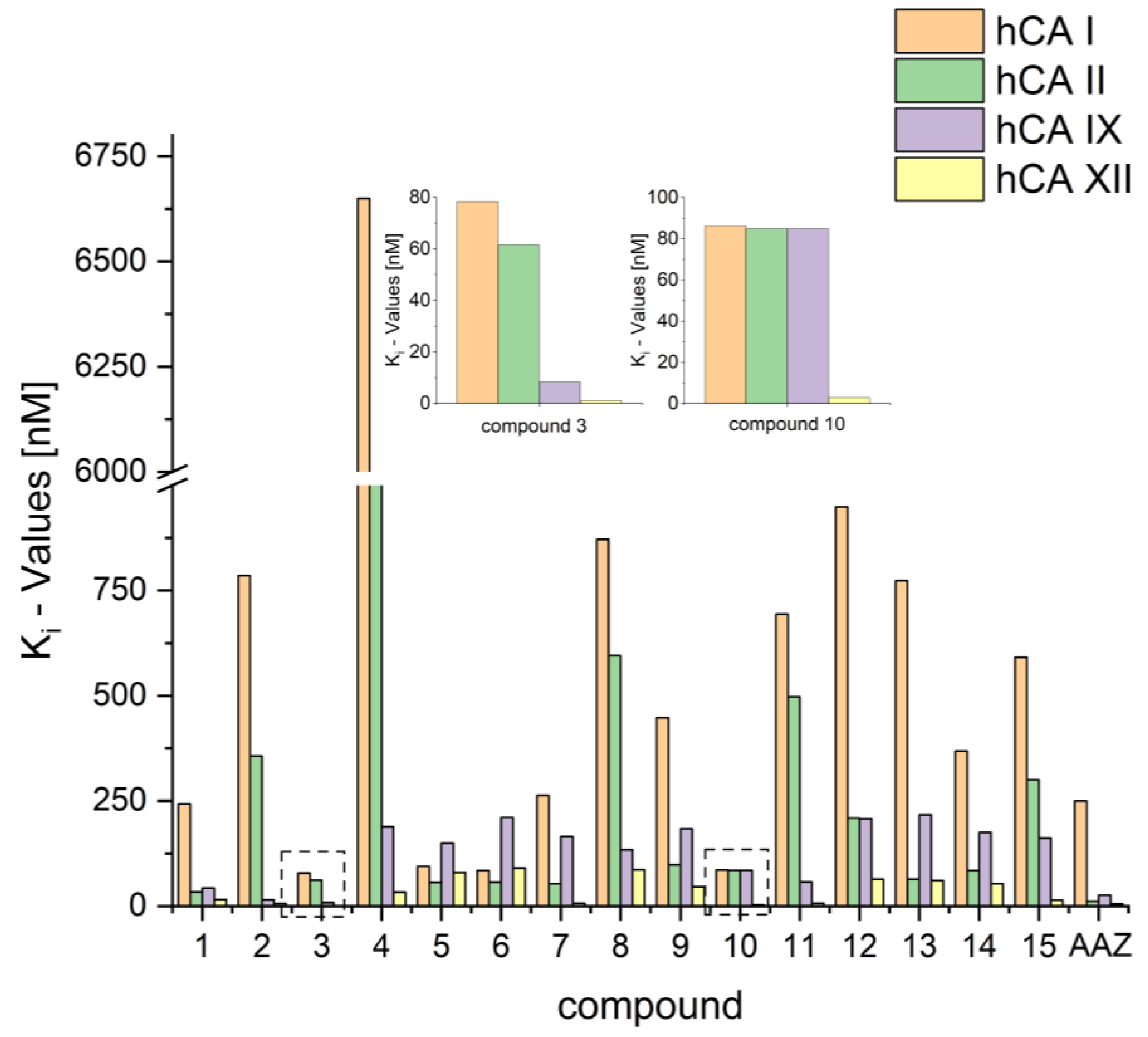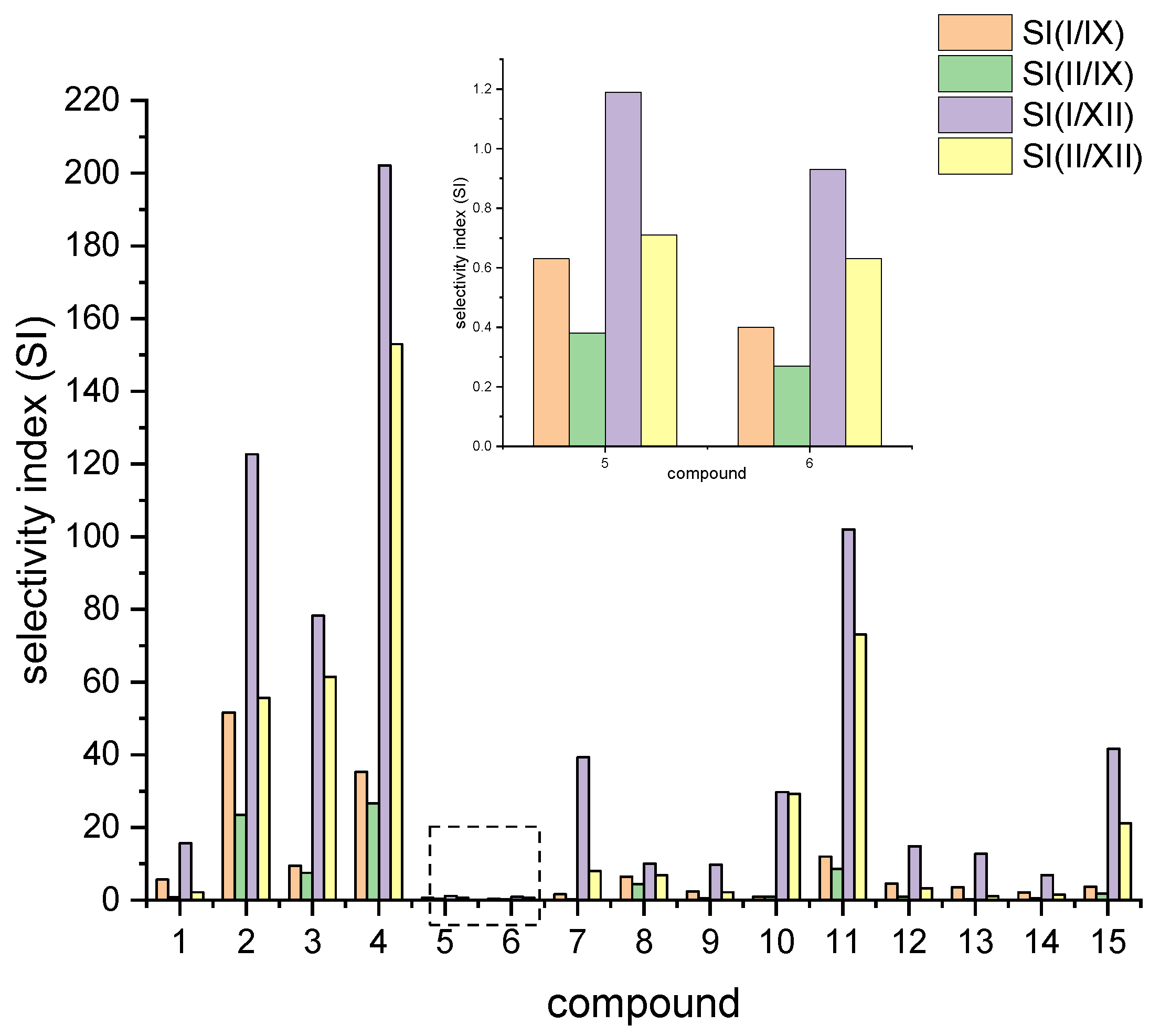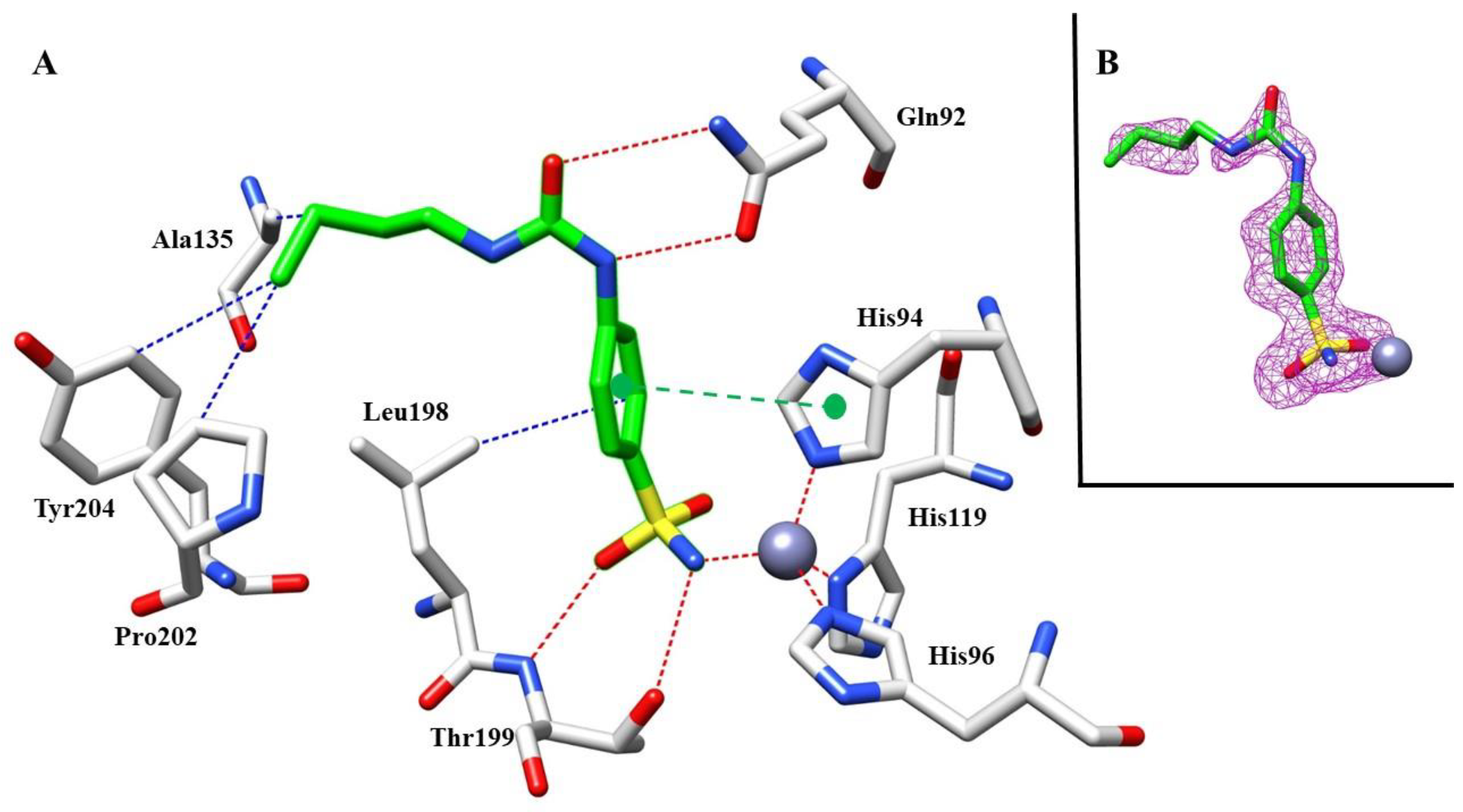Ureidobenzenesulfonamides as Selective Carbonic Anhydrase I, IX, and XII Inhibitors
Abstract
:1. Introduction
2. Results
3. Experimental Procedure
3.1. General Procedure for the Synthesis of Compounds 1–13 (GP)
3.1.1. 4-[3-(Naphthalen-1-yl)ureido]benzenesulfonamide (1)
3.1.2. 4-[3-(4-Benzylphenyl)ureido]benzenesulfonamide (2)
3.1.3. 4-[3-(2-Benzylphenyl)ureido])benzenesulfonamide (3)
3.1.4. 4-{3-[(4-Methoxy-(1,1′-biphenyl)-3-yl]ureido}benzenesulfonamide (4)
3.1.5. 4-[3-(4-Methoxyphenyl)ureido])benzenesulfonamide (5)
3.1.6. 4-[3-(3-Methoxyphenyl)ureido]benzenesulfonamide (6)
3.1.7. 4-[3-(3-Fluorophenyl)ureido]benzenesulfonamide (7)
3.1.8. 4-(3-Ethylureido)benzenesulfonamide (8)
3.1.9. 4-(3-Isopropylureido)benzenesulfonamide (9)
3.1.10. 4-(3-Butylureido)benzenesulfonamide (10)
3.1.11. 4-(3-Hexylureido)benzenesulfonamide (11)
3.1.12. N-[(4-Sulfamoylphenyl)carbamoyl]benzamide (12)
3.1.13. Ethyl 4-[3-(4-sulfamoylphenyl)ureido]benzoate (13)
3.1.14. 4-[3-(4-Sulfamoylphenyl)ureido]benzoic acid (14)
3.1.15. 4-[3-(5-Chloro-2-phenoxyphenyl)ureido]benzenesulfonamide (15)
3.2. Crystallization and X-ray Data Collection
3.3. Structure Determination
4. Conclusions
Supplementary Materials
Author Contributions
Funding
Institutional Review Board Statement
Informed Consent Statement
Data Availability Statement
Acknowledgments
Conflicts of Interest
References
- Gelmo, P. Sulphamides of p-Aminobenzenesulphonic Acid. Vienna. J. Prakt Chem. 1908, 77, 369–382. [Google Scholar] [CrossRef]
- Mietzsch, F. The chemotherapy of bacterial infections. Ber. Dtsch. Chem. Ges. A 1938, 71A, 15–28. [Google Scholar]
- Domagk, G. Chemotherapy of bacterial infections. Dtsch. Med. Wochenschr. 1935, 61, 250–253. [Google Scholar] [CrossRef]
- Mann, T.; Keilin, D. Sulfanilamide as a specific inhibitor of carbonic anhydrase. Nature 1940, 146, 164. [Google Scholar] [CrossRef]
- Earnhardt, J.N.; Qian, M.Z.; Tu, C.K.; Lakkis, M.M.; Bergenhem, N.C.H.; Laipis, P.J.; Tashian, R.E.; Silverman, D.N. The catalytic properties of murine carbonic anhydrase VII. Biochemistry 1998, 37, 10837–10845. [Google Scholar] [CrossRef]
- Chiche, J.; LeFloch, R.; Ilc, K.; Roux, D.; Pouyssegur, J. Tumour metabolic adaptation to hypoxic and acidic stress. Ejc Suppl. 2010, 8, 86. [Google Scholar] [CrossRef]
- Fang, J.S.; Gillies, R.D.; Gatenby, R.A. Adaptation to hypoxia and acidosis in carcinogenesis and tumor progression. Semin. Cancer Biol. 2008, 18, 330–337. [Google Scholar] [CrossRef]
- Verduzco, D.; Lloyd, M.; Xu, L.P.; Ibrahim-Hashim, A.; Balagurunathan, Y.; Gatenby, R.A.; Gillies, R.J. Intermittent Hypoxia Selects for Genotypes and Phenotypes That Increase Survival, Invasion, and Therapy Resistance. PLoS ONE 2015, 10, e0120958. [Google Scholar] [CrossRef]
- Carta, F.; Vullo, D.; Osman, S.M.; AlOthman, Z.; Supuran, C.T. Synthesis and carbonic anhydrase inhibition of a series of SLC-011.1 analogs. Bioorgan. Med. Chem. 2017, 25, 2569–2576. [Google Scholar] [CrossRef]
- Singh, S.; Lomelino, C.L.; Mboge, M.Y.; Frost, S.C.; McKenna, R. Cancer Drug Development of Carbonic Anhydrase Inhibitors beyond the Active Site. Molecules 2018, 23, 1045. [Google Scholar] [CrossRef]
- Andreucci, E.; Ruzzolini, J.; Peppicelli, S.; Bianchini, F.; Laurenzana, A.; Carta, F.; Supuran, C.T.; Calorini, L. The carbonic anhydrase IX inhibitor SLC-0111 sensitises cancer cells to conventional chemotherapy. J. Enzym. Inhib. Med. Chem. 2019, 34, 117–123. [Google Scholar] [CrossRef]
- Eldehna, W.M.; Fares, M.; Ceruso, M.; Ghabbour, H.A.; Abou-Seri, S.M.; Abdel-Aziz, H.A.; Abou El Ella, D.A.; Supuran, C.T. Amido/ureidosubstituted benzenesulfonamides-isatin conjugates as low nanomolar/subnanomolar inhibitors of the tumor-associated carbonic anhydrase isoform XII. Eur. J. Med. Chem. 2016, 110, 259–266. [Google Scholar] [CrossRef] [PubMed]
- Gul, H.I.; Yamali, C.; Sakagami, H.; Angeli, A.; Leitans, J.; Kazaks, A.; Tars, K.; Ozgun, D.O.; Supuran, C.T. New anticancer drug canditates sulfonamides as selective hCA IX or hCA XII inhibitors. Bioorg. Chem. 2018, 77, 411–419. [Google Scholar] [CrossRef]
- Mboge, M.Y.; Mahon, B.P.; Lamas, N.; Socorro, L.; Carta, F.; Supuran, C.T.; Frost, S.C.; McKenna, R. Structure activity study of carbonic anhydrase IX: Selective inhibition with ureido-substituted benzenesulfonamides. Eur. J. Med. Chem. 2017, 132, 184–191. [Google Scholar] [CrossRef] [PubMed]
- Peerzada, M.N.; Khan, P.; Ahmad, K.; Hassan, M.I.; Azam, A. Synthesis, characterization and biological evaluation of tertiary sulfonamide derivatives of pyridyl-indole based heteroaryl chalcone as potential carbonic anhydrase IX inhibitors and anticancer agents. Eur. J. Med. Chem. 2018, 155, 13–23. [Google Scholar] [CrossRef] [PubMed]
- Supuran, C.T. Carbonic anhydrase inhibitors as emerging agents for the treatment and imaging of hypoxic tumors. Expert Opin. Investig. Drugs 2018, 27, 963–970. [Google Scholar] [CrossRef] [PubMed]
- Winum, J.Y.; Rami, M.; Scozzafava, A.; Montero, J.L.; Supuran, C. Carbonic anhydrase IX: A new druggable target for the design of antitumor agents. Med. Res. Rev. 2008, 28, 445–463. [Google Scholar] [CrossRef]
- McDonald, P.C.; Chia, S.; Bedard, P.L.; Chu, Q.; Lyle, M.; Tang, L.R.; Singh, M.; Zhang, Z.H.; Supuran, C.T.; Renouf, D.J.; et al. A Phase 1 Study of SLC-0111, a Novel Inhibitor of Carbonic Anhydrase IX, in Patients With Advanced Solid Tumors. Am. J. Clin. Oncol. 2020, 43, 484–490. [Google Scholar] [CrossRef]
- Supuran, C.T. Carbonic anhydrase inhibitors: An update on experimental agents for the treatment and imaging of hypoxic tumors. Expert. Opin. Investig. Drug 2021, 30, 1197–1208. [Google Scholar] [CrossRef]
- Supuran, C.T. Latest advances in specific inhibition of tumor-associated carbonic anhydrases. Future Med. Chem. 2023, 15, 5–7. [Google Scholar] [CrossRef]
- Serbian, I.; Schwarzenberger, P.; Loesche, A.; Hoenke, S.; Al-Harrasi, A.; Csuk, R. Ureidobenzenesulfonamides as efficient inhibitors of carbonic anhydrase II. Bioorg. Chem. 2019, 91, 103123. [Google Scholar] [CrossRef] [PubMed]
- Tham, Y.-C.; Li, X.; Wong, T.Y.; Quigley, H.A.; Aung, T.; Cheng, C.-Y. Global Prevalence of Glaucoma and Projections of Glaucoma Burden through 2040: A Systematic Review and Meta-Analysis. Ophthalmology 2014, 121, 2081–2090. [Google Scholar] [CrossRef]
- van Dyck, C.H.; Swanson, C.J.; Aisen, P.; Bateman, R.J.; Chen, C.; Gee, M.; Kanekiyo, M.; Li, D.; Reyderman, L.; Cohen, S.; et al. Lecanemab in Early Alzheimers Disease. N. Engl. J. Med. 2023, 388, 9–21. [Google Scholar] [CrossRef]
- Doggrell, S.A. Still grasping at straws: Donanemab in Alzheimer’s disease. Expert Opin. Invest Drugs 2021, 30, 797–801. [Google Scholar] [CrossRef] [PubMed]
- Mintun, M.A.; Lo, A.C.; Evans, C.D.; Wessels, A.M.; Ardayfio, P.A.; Andersen, S.W.; Shcherbinin, S.; Sparks, J.; Sims, J.R.; Brys, M.; et al. Donanemab in early Alzheimer’s disease. N. Engl. J. Med. 2021, 384, 1691–1704. [Google Scholar] [CrossRef] [PubMed]
- Hao, J.-Q.; He, X.-Y.; Yang, X.; Xiao, Y.-C.; Duan, S.-Q.; Wang, H.; Bai, H.; Zhang, Y.; Shi, J.-Y.; Zhu, X.-l.; et al. Acetazolamide Alleviate Cerebral Edema Induced by Ischemic Stroke Through Inhibiting the Expression of AQP4 mRNA. Neurocrit. Care 2022, 36, 97–105. [Google Scholar] [CrossRef] [PubMed]
- Wright, A.D.; Breary, S.P.; Imray, C.H.E. High hopes at high altitudes: Pharmacotherapy for acute mountain sickness and high-altitude cerebral and pulmonary oedema. Expert Opin. Pharmacother. 2008, 9, 119–127. [Google Scholar] [CrossRef]
- Vannozzi, G.; Vullo, D.; Angeli, A.; Ferraroni, M.; Combs, J.; Lomelino, C.; Andring, J.; Mckenna, R.; Bartolucci, G.; Pallecchi, M.; et al. One-Pot Procedure for the Synthesis of Asymmetric Substituted Ureido Benzene Sulfonamides as Effective Inhibitors of Carbonic Anhydrase Enzymes. J. Med. Chem. 2022, 65, 824–837. [Google Scholar] [CrossRef]
- Supuran, C.T. A simple yet multifaceted 90 years old, evergreen enzyme: Carbonic anhydrase, its inhibition and activation. Bioorg. Med. Chem. Lett. 2023, 93, 129411. [Google Scholar] [CrossRef]
- Leslie, A.G.W.; Powell, H.R. Procesing diffraction data with mosflm. In Evolving Methods for Macromolecular Crystallography; Read, R.J., Sussman, J.L., Eds.; Springer: Dordrecht, The Netherlands, 2007; Volume 245, pp. 41–51. [Google Scholar]
- Murshudov, G.N.; Vagin, A.A.; Dodson, E.J. Refinement of macromolecular structures by the maximum-likelihood method. Acta Crystallogr. D Biol. Crystallogr. 1997, 53, 240–255. [Google Scholar] [CrossRef]
- Emsley, P.; Lohkamp, B.; Scott, W.; Cowtan, K. Features and development of Coot. Acta Crystallogr. D Biol. Crystallogr. 2010, 66, 486–501. [Google Scholar] [CrossRef] [PubMed]
- Lovell, S.C.; Davis, I.W.; Arendall III, W.B.; de Bakker, P.I.W.; Word, J.M.; Prisant, M.G.; Richardson, J.S.; Richardson, D.C. Structure validation by Cα geometry: ϕ,ψ and Cβ deviation. Proteins 2003, 50, 437–450. [Google Scholar] [CrossRef] [PubMed]
- Pettersen, E.F.; Goddard, T.D.; Huang, C.C.; Couch, G.S.; Greenblatt, D.M.; Meng, E.C.; Ferrin, T.E. UCSF Chimera—A visualization system for exploratory research and analysis. J. Comput. Chem. 2004, 25, 1605–1612. [Google Scholar] [CrossRef] [PubMed]








| Cmp | hCA I | hCA II | hCA IX | S(I/IX) | S(II/IX) | hCA XII | S(I/XII) | S(II/XII) |
|---|---|---|---|---|---|---|---|---|
| 1 | 242.8 | 33.5 | 42.9 | 5.66 | 0.78 | 15.5 | 15.66 | 2.16 |
| 2 | 785.2 | 356.2 | 15.2 | 51.66 | 23.43 | 6.4 | 122.69 | 55.66 |
| 3 | 78.3 | 61.5 | 8.2 | 9.55 | 7.50 | 1 | 78.30 | 61.50 |
| 4 | 6650 | 5034 | 188.6 | 35.26 | 26.69 | 32.9 | 202.13 | 153.01 |
| 5 | 94.4 | 56.5 | 149.7 | 0.63 | 0.38 | 79.6 | 1.19 | 0.71 |
| 6 | 84.5 | 56.8 | 210.4 | 0.40 | 0.27 | 90.4 | 0.93 | 0.63 |
| 7 | 263.3 | 53.6 | 165.3 | 1.59 | 0.32 | 6.7 | 39.30 | 8.00 |
| 8 | 871.6 | 595.2 | 134.3 | 6.49 | 4.43 | 86.5 | 10.08 | 6.88 |
| 9 | 447.7 | 98.6 | 183.7 | 2.44 | 0.54 | 45.9 | 9.75 | 2.15 |
| 10 | 86.2 | 84.9 | 84.9 | 1.02 | 1.00 | 2.9 | 29.72 | 29.28 |
| 11 | 693.9 | 497.1 | 57.7 | 12.03 | 8.62 | 6.8 | 102.04 | 73.10 |
| 12 | 948.5 | 209.2 | 207.7 | 4.57 | 1.01 | 63.9 | 14.84 | 3.27 |
| 13 | 773.3 | 63.5 | 216.7 | 3.57 | 0.29 | 60.7 | 12.74 | 1.05 |
| 14 | 368.1 | 84.4 | 174.9 | 2.10 | 0.48 | 53.4 | 6.89 | 1.58 |
| 15 | 591.1 | 300.4 | 161.4 | 3.66 | 1.86 | 14.2 | 41.63 | 21.15 |
| SLC-0111 | 5080 | 960 | 45.1 | 112.6 | 21.3 | 4.5 | 1128.9 | 213.3 |
| AAZ | 250 | 12.1 | 25.8 | 9.69 | 0.47 | 5.7 | 43.86 | 2.12 |
Disclaimer/Publisher’s Note: The statements, opinions and data contained in all publications are solely those of the individual author(s) and contributor(s) and not of MDPI and/or the editor(s). MDPI and/or the editor(s) disclaim responsibility for any injury to people or property resulting from any ideas, methods, instructions or products referred to in the content. |
© 2023 by the authors. Licensee MDPI, Basel, Switzerland. This article is an open access article distributed under the terms and conditions of the Creative Commons Attribution (CC BY) license (https://creativecommons.org/licenses/by/4.0/).
Share and Cite
Denner, T.C.; Angeli, A.; Ferraroni, M.; Supuran, C.T.; Csuk, R. Ureidobenzenesulfonamides as Selective Carbonic Anhydrase I, IX, and XII Inhibitors. Molecules 2023, 28, 7782. https://doi.org/10.3390/molecules28237782
Denner TC, Angeli A, Ferraroni M, Supuran CT, Csuk R. Ureidobenzenesulfonamides as Selective Carbonic Anhydrase I, IX, and XII Inhibitors. Molecules. 2023; 28(23):7782. https://doi.org/10.3390/molecules28237782
Chicago/Turabian StyleDenner, Toni C., Andrea Angeli, Marta Ferraroni, Claudiu T. Supuran, and René Csuk. 2023. "Ureidobenzenesulfonamides as Selective Carbonic Anhydrase I, IX, and XII Inhibitors" Molecules 28, no. 23: 7782. https://doi.org/10.3390/molecules28237782
APA StyleDenner, T. C., Angeli, A., Ferraroni, M., Supuran, C. T., & Csuk, R. (2023). Ureidobenzenesulfonamides as Selective Carbonic Anhydrase I, IX, and XII Inhibitors. Molecules, 28(23), 7782. https://doi.org/10.3390/molecules28237782










